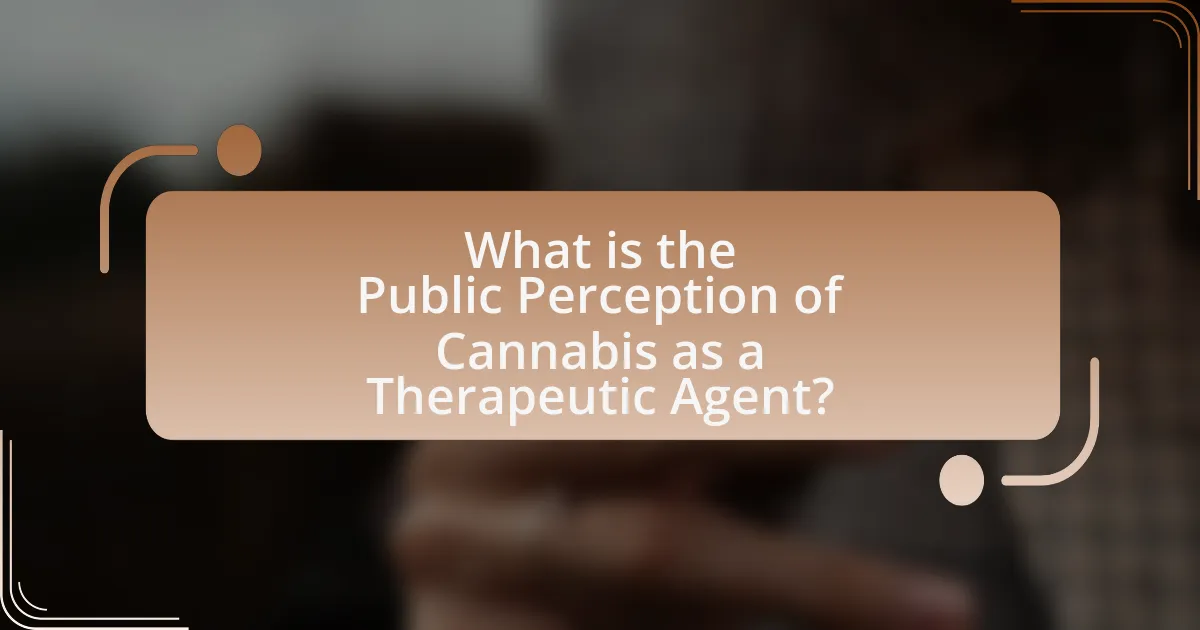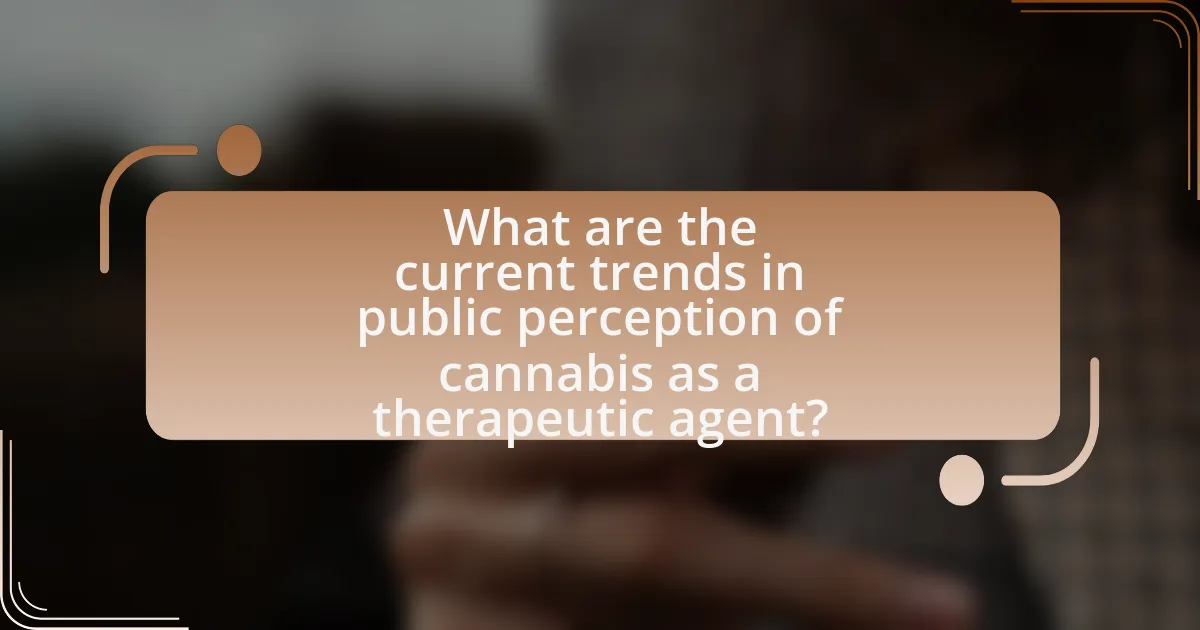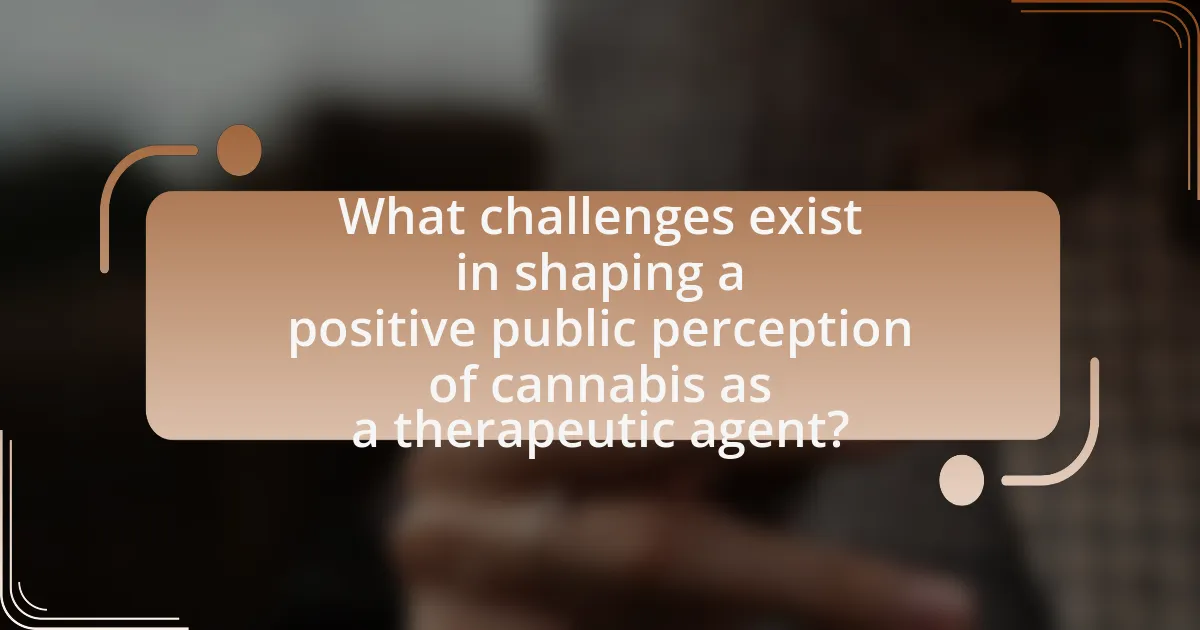The article examines the evolving public perception of cannabis as a therapeutic agent, highlighting a significant shift towards acceptance and recognition of its medical benefits. Recent surveys indicate that a majority of Americans support the legalization of cannabis for medical use, driven by research demonstrating its efficacy in treating conditions such as chronic pain and epilepsy. Historical events, cultural attitudes, and media representations have shaped these perceptions, while personal experiences and demographic factors further influence public opinion. The article also addresses challenges in overcoming misconceptions and misinformation surrounding cannabis, emphasizing the importance of education and community engagement in fostering a positive view of cannabis therapy.

What is the Public Perception of Cannabis as a Therapeutic Agent?
The public perception of cannabis as a therapeutic agent is increasingly positive, with a significant portion of the population recognizing its potential medical benefits. According to a 2021 Gallup poll, 68% of Americans support legalizing cannabis for medical use, reflecting a growing acceptance of its therapeutic applications. Research indicates that cannabis may alleviate symptoms associated with various conditions, such as chronic pain, epilepsy, and multiple sclerosis, further influencing public opinion. Additionally, studies published in journals like the Journal of Pain Research highlight the efficacy of cannabinoids in pain management, reinforcing the perception of cannabis as a legitimate therapeutic option.
How has public perception of cannabis evolved over time?
Public perception of cannabis has evolved significantly from widespread stigma and criminalization to increasing acceptance and recognition of its therapeutic benefits. In the early 20th century, cannabis was largely viewed negatively, associated with criminal activity and mental health issues, leading to its prohibition in many countries. However, starting in the late 20th century, particularly in the 1990s, public attitudes began to shift as research highlighted potential medical uses, such as pain relief and treatment for conditions like epilepsy and multiple sclerosis. By 2020, a Gallup poll indicated that 68% of Americans supported legalizing cannabis, reflecting a dramatic change in perception. This evolution is further supported by the legalization of medical cannabis in over 30 states and recreational use in several others, demonstrating a growing recognition of its therapeutic potential.
What historical events have influenced public views on cannabis?
The historical events that have influenced public views on cannabis include the Marihuana Tax Act of 1937, which effectively criminalized cannabis in the United States, and the counterculture movement of the 1960s, which advocated for cannabis legalization. The Marihuana Tax Act led to widespread stigma and negative perceptions of cannabis, associating it with crime and moral decay. In contrast, the 1960s counterculture movement challenged these views, promoting cannabis as a symbol of rebellion and personal freedom. Additionally, the War on Drugs initiated in the 1980s further entrenched negative perceptions by emphasizing the dangers of drug use, including cannabis. Recent events, such as the legalization of cannabis for medical and recreational use in various states and countries, have shifted public opinion towards a more favorable view, recognizing its therapeutic potential.
How do cultural attitudes shape perceptions of cannabis?
Cultural attitudes significantly shape perceptions of cannabis by influencing societal norms, legal frameworks, and individual beliefs about its use. For instance, in cultures where cannabis is historically stigmatized, such as in many Western countries, perceptions often lean towards viewing it as a harmful substance, which can lead to restrictive laws and limited acceptance of its therapeutic benefits. Conversely, in cultures where cannabis has been traditionally used for medicinal purposes, such as in parts of Asia and the Middle East, there is often a more favorable view, leading to greater acceptance and integration into healthcare practices. Research indicates that public opinion on cannabis is closely tied to cultural narratives; for example, a 2020 study published in the Journal of Drug Issues found that countries with progressive drug policies and positive cultural attitudes towards cannabis reported higher rates of acceptance for its medicinal use.
What factors contribute to public perception of cannabis as a therapeutic agent?
Public perception of cannabis as a therapeutic agent is influenced by several key factors, including scientific research, media representation, personal experiences, and cultural attitudes. Scientific studies, such as those published in journals like the Journal of Pain and Symptom Management, demonstrate the efficacy of cannabis in treating conditions like chronic pain and epilepsy, which can enhance public trust in its therapeutic potential. Media portrayal, whether positive or negative, shapes societal views; for instance, documentaries highlighting successful medical cannabis cases can foster acceptance. Personal anecdotes from patients who have benefited from cannabis therapy also play a significant role in shaping perceptions, as they provide relatable evidence of its effectiveness. Additionally, cultural attitudes towards cannabis, influenced by historical context and legal status, further impact how the public views its therapeutic use.
How do media representations affect public opinion on cannabis?
Media representations significantly shape public opinion on cannabis by influencing perceptions of its safety, efficacy, and legality. For instance, positive portrayals in news outlets and documentaries can lead to increased acceptance and support for cannabis legalization, as evidenced by a 2019 study published in the journal “Health Affairs,” which found that media coverage correlates with shifts in public attitudes toward cannabis reform. Conversely, negative representations, often emphasizing risks or criminality, can reinforce stigma and opposition to cannabis use. This dynamic illustrates how the framing of cannabis in media can directly impact societal views and policy decisions regarding its therapeutic use.
What role do personal experiences play in shaping perceptions?
Personal experiences significantly influence perceptions by providing individuals with firsthand knowledge and emotional connections to specific subjects. In the context of cannabis as a therapeutic agent, personal experiences can lead to varying opinions based on individual outcomes, such as pain relief or adverse effects. Research indicates that individuals who have used cannabis for medical purposes often report positive effects, which can shape their perception and advocacy for its therapeutic use. For instance, a study published in the Journal of Psychoactive Drugs found that patients using cannabis for chronic pain reported improved quality of life, reinforcing their belief in its efficacy. Thus, personal experiences serve as a powerful lens through which individuals interpret and form opinions about cannabis as a therapeutic agent.
Why is public perception important for cannabis legalization and use?
Public perception is crucial for cannabis legalization and use because it directly influences policy decisions and societal acceptance. When the majority of the public views cannabis positively, lawmakers are more likely to support legalization efforts, as seen in states like Colorado and California, where public support led to successful legalization initiatives. Additionally, favorable public perception can reduce stigma, encouraging individuals to seek cannabis for therapeutic purposes, which is supported by research indicating that 83% of Americans believe cannabis should be legal for medical use. Thus, public perception shapes both legislative action and the willingness of individuals to utilize cannabis as a therapeutic agent.
How does public perception influence policy decisions regarding cannabis?
Public perception significantly influences policy decisions regarding cannabis by shaping lawmakers’ views and public health initiatives. When a majority of the population supports cannabis legalization or recognizes its therapeutic benefits, policymakers are more likely to enact laws that reflect these sentiments. For instance, a 2021 Gallup poll indicated that 68% of Americans favored legalizing cannabis, which has led to numerous states legalizing its use for both medical and recreational purposes. This correlation between public opinion and legislative action demonstrates that as societal attitudes evolve, so too do the policies governing cannabis.
What impact does perception have on patient access to cannabis therapies?
Perception significantly impacts patient access to cannabis therapies by influencing public attitudes, regulatory policies, and healthcare provider recommendations. Positive perceptions of cannabis as a legitimate therapeutic agent can lead to more supportive legislation and increased availability of cannabis products, as seen in states where medical cannabis is legalized. Conversely, negative perceptions can result in restrictive laws and hesitance among healthcare providers to recommend cannabis, limiting patient access. For instance, a study published in the Journal of Psychoactive Drugs found that states with more favorable public attitudes towards cannabis had higher rates of medical cannabis use among patients, demonstrating a direct correlation between perception and access.

What are the current trends in public perception of cannabis as a therapeutic agent?
Current trends indicate a growing acceptance of cannabis as a therapeutic agent among the public. Recent surveys show that approximately 91% of Americans support the use of cannabis for medical purposes, reflecting a significant shift in perception over the past decade. This change is largely driven by increasing awareness of the potential benefits of cannabis in treating conditions such as chronic pain, anxiety, and epilepsy, supported by studies like the 2017 National Academies of Sciences report, which concluded that there is substantial evidence for the efficacy of cannabis in treating chronic pain and spasticity. Additionally, the legalization of medical cannabis in numerous states has contributed to a more favorable view, with many individuals reporting positive experiences with its use for health-related issues.
How do demographics affect perceptions of cannabis therapy?
Demographics significantly influence perceptions of cannabis therapy, with factors such as age, gender, education, and geographic location playing crucial roles. For instance, younger individuals tend to have more favorable views towards cannabis therapy compared to older adults, who may associate it with stigma or negative health outcomes. Research indicates that a 2019 study published in the Journal of Psychoactive Drugs found that individuals aged 18-29 were 50% more likely to support cannabis legalization for therapeutic use than those over 65. Additionally, gender differences reveal that women are often more open to cannabis therapy than men, with a 2020 survey by the Pew Research Center showing that 62% of women support medical cannabis compared to 54% of men. Education levels also correlate with perceptions; higher education is linked to more positive attitudes towards cannabis therapy, as noted in a 2021 study in the Journal of Drug Issues, which found that college graduates were 40% more likely to endorse its therapeutic benefits. Geographic location further affects perceptions, with urban residents generally more supportive of cannabis therapy than those in rural areas, as evidenced by a 2022 report from the National Institute on Drug Abuse, which highlighted that urban areas had a 30% higher acceptance rate for cannabis as a medical treatment.
What differences exist in perception among various age groups?
Perception of cannabis as a therapeutic agent varies significantly among different age groups. Younger individuals, particularly those aged 18-34, tend to view cannabis more favorably, often associating it with recreational use and potential health benefits, as evidenced by a 2021 Gallup poll indicating that 70% of this age group supports legalization. In contrast, older adults, especially those over 65, generally exhibit more skepticism, often influenced by historical stigma and concerns about safety and efficacy; a 2020 study published in the Journal of Psychoactive Drugs found that only 30% of seniors believed cannabis could be beneficial for medical purposes. This divergence in perception highlights the impact of generational attitudes and cultural context on the acceptance of cannabis as a therapeutic option.
How do geographic locations influence public views on cannabis?
Geographic locations significantly influence public views on cannabis due to varying cultural, legal, and economic contexts. For instance, states in the U.S. that have legalized cannabis, such as California and Colorado, generally exhibit more positive attitudes towards its use, with surveys indicating that over 60% of residents support legalization. In contrast, regions where cannabis remains illegal, like many Southern states, often reflect more negative perceptions, influenced by historical stigma and conservative values. Additionally, urban areas tend to show more progressive views compared to rural regions, where traditional beliefs may prevail. This disparity is supported by research from the Pew Research Center, which found that public support for cannabis legalization is higher in urban populations compared to rural ones, highlighting the impact of geographic location on societal attitudes towards cannabis.
What recent studies highlight changes in public perception?
Recent studies indicate a significant shift in public perception regarding cannabis as a therapeutic agent. A 2022 survey conducted by the Pew Research Center found that 91% of Americans support legalizing cannabis for medical use, reflecting a growing acceptance compared to previous years. Additionally, a study published in the Journal of Psychoactive Drugs in 2023 revealed that 67% of respondents believe cannabis can effectively treat chronic pain, up from 54% in 2019. These findings underscore a notable trend towards recognizing cannabis’s potential therapeutic benefits, influenced by increasing legalization and research supporting its medical applications.
What findings have emerged from surveys on cannabis use for medical purposes?
Surveys on cannabis use for medical purposes have revealed that a significant majority of respondents support its therapeutic applications. For instance, a 2021 survey conducted by the Pew Research Center found that 91% of Americans believe cannabis should be legal for medical use. Additionally, surveys indicate that patients report positive outcomes, with studies showing that approximately 70% of medical cannabis users experience relief from chronic pain and other symptoms. These findings underscore a growing acceptance and recognition of cannabis as a viable treatment option among the public.
How do these studies reflect broader societal attitudes towards cannabis?
Studies on cannabis use as a therapeutic agent reflect a growing acceptance of cannabis in society, indicating a shift from stigma to recognition of its potential benefits. For instance, research published in the Journal of Psychoactive Drugs shows that public support for medical cannabis has increased significantly, with a 2021 survey revealing that over 70% of Americans favor legalization for medical purposes. This trend mirrors broader societal attitudes that increasingly view cannabis not just as a recreational substance but as a legitimate treatment option for various medical conditions, such as chronic pain and anxiety. Furthermore, the National Institute on Drug Abuse reports that states with legalized medical cannabis have seen a decrease in opioid prescriptions, suggesting a societal shift towards alternative therapies.

What challenges exist in shaping a positive public perception of cannabis as a therapeutic agent?
Shaping a positive public perception of cannabis as a therapeutic agent faces several challenges, primarily stemming from historical stigma, regulatory barriers, and misinformation. Historical stigma arises from decades of cannabis prohibition and negative portrayals in media, which have ingrained a perception of cannabis as a harmful substance rather than a legitimate medical option. Regulatory barriers, including varying legal statuses across regions, hinder research and access, limiting public understanding of its therapeutic benefits. Misinformation, often propagated by both media and social platforms, leads to confusion about the efficacy and safety of cannabis for medical use. For instance, a 2020 study published in the Journal of Cannabis Research highlighted that misconceptions about cannabis persist despite increasing evidence of its medical benefits, indicating a significant gap between scientific findings and public perception.
What misconceptions about cannabis therapy persist in public discourse?
Misconceptions about cannabis therapy that persist in public discourse include the belief that it is solely a recreational drug with no medical benefits, that it is highly addictive, and that it causes significant cognitive impairment. Research indicates that cannabis contains compounds, such as cannabinoids, which have therapeutic properties for conditions like chronic pain, epilepsy, and multiple sclerosis. A study published in the Journal of the American Medical Association found that cannabis can effectively reduce chronic pain in adults, challenging the notion that it lacks medical utility. Additionally, while some individuals may develop a dependence on cannabis, studies show that the addiction rate is lower than that of substances like alcohol or opioids. Furthermore, evidence suggests that moderate cannabis use does not lead to lasting cognitive decline, contradicting the belief that it severely impairs mental function.
How do myths about cannabis efficacy affect public opinion?
Myths about cannabis efficacy significantly shape public opinion by perpetuating misconceptions regarding its therapeutic benefits. These myths often lead to skepticism about cannabis as a legitimate treatment option, influencing individuals’ attitudes toward its legalization and medical use. For instance, a 2019 survey by the Pew Research Center found that 62% of Americans support legalizing cannabis, yet many still hold onto outdated beliefs about its risks and benefits, which can hinder broader acceptance. Additionally, misinformation can create fear and stigma, further complicating discussions around cannabis as a therapeutic agent.
What misinformation is commonly spread regarding cannabis safety?
Common misinformation regarding cannabis safety includes the belief that cannabis is entirely harmless and cannot cause any adverse effects. This misconception overlooks evidence that cannabis use can lead to negative health outcomes, such as impaired cognitive function, increased risk of mental health disorders, and potential addiction. Research published in the journal “The Lancet Psychiatry” indicates that regular cannabis use is associated with a higher likelihood of developing psychosis, particularly in individuals with a predisposition to mental health issues. Additionally, the National Institute on Drug Abuse reports that cannabis can impair motor skills and reaction times, posing risks, especially when driving.
How can advocates improve public perception of cannabis as a therapeutic agent?
Advocates can improve public perception of cannabis as a therapeutic agent by providing evidence-based information about its medical benefits and promoting patient testimonials. Research indicates that cannabis can effectively alleviate symptoms of chronic pain, epilepsy, and multiple sclerosis, as demonstrated in studies published in journals such as the Journal of Pain and the New England Journal of Medicine. By sharing these findings and real-life success stories, advocates can counteract stigma and misinformation surrounding cannabis use. Additionally, engaging in community outreach and educational campaigns can further enhance understanding and acceptance of cannabis as a legitimate therapeutic option.
What strategies can be employed to educate the public about cannabis benefits?
To educate the public about cannabis benefits, comprehensive public awareness campaigns can be employed. These campaigns should utilize multiple platforms, including social media, community workshops, and informational websites, to disseminate accurate information about the therapeutic uses of cannabis. Research indicates that educational interventions can significantly improve knowledge and attitudes toward cannabis; for instance, a study published in the Journal of Psychoactive Drugs found that educational programs increased awareness of cannabis’s medicinal properties among participants. Additionally, collaboration with healthcare professionals can enhance credibility and provide evidence-based information, further supporting public understanding of cannabis as a therapeutic agent.
How can community engagement initiatives foster a better understanding of cannabis therapy?
Community engagement initiatives can foster a better understanding of cannabis therapy by facilitating direct interactions between healthcare professionals, patients, and the community. These initiatives often include educational workshops, public forums, and informational campaigns that provide evidence-based information about the therapeutic benefits and risks associated with cannabis use. For instance, a study published in the Journal of Cannabis Research found that community education programs significantly increased knowledge and reduced stigma surrounding cannabis therapy among participants. By promoting open dialogue and sharing personal experiences, these initiatives help demystify cannabis therapy, leading to informed decision-making and improved public perception.
What practical steps can individuals take to contribute to a positive perception of cannabis?
Individuals can contribute to a positive perception of cannabis by educating themselves and others about its benefits and responsible use. Engaging in informed discussions can dispel myths and highlight scientific research, such as studies showing cannabis’s efficacy in treating chronic pain and epilepsy. Additionally, advocating for policy changes that support medical cannabis can further enhance its acceptance; for instance, the National Academies of Sciences, Engineering, and Medicine reported in 2017 that there is substantial evidence for the therapeutic effects of cannabis in certain medical conditions. By sharing personal experiences and supporting local cannabis businesses, individuals can also foster a community that views cannabis positively.


